Petrus Christus
Paintings
Virgin and Child
The Lamentation
A Goldsmith in his Shop
Portrait of a Young Man
Head of Christ
Portrait of a Man
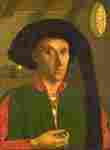
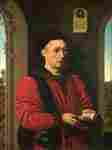

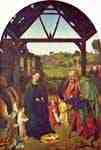
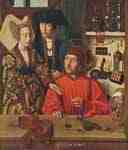


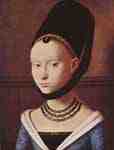
Fine Art Prints | Greeting Cards | iPhone Cases | Tote Bags | Clothing | Lifestyle | Beach ...
Petrus Christus (c. 1410/1420 – 1475/1476) was an Early Netherlandish painter active in Bruges from 1444, where, along with Hans Memling, he became the leading painter after the death of Jan van Eyck. He was influenced by van Eyck and Rogier van der Weyden and is noted for his innovations with linear perspective and a meticulous technique which seems derived from miniatures and manuscript illumination. Today, some 30 works are confidently attributed to him.
.[1] The best-known include the 1446 Portrait of a Carthusian and c. 1470 Berlin Portrait of a Young Girl, both are highly innovative in presentation of the figure against detailed, rather than flat, backgrounds.
Christus was an anonymous figure for centuries, his importance not established until the work of modern art historians. Giorgio Vasari barely mentions him in his biographies of painters, written in the Renaissance, and near contemporary records merely list him amongst many others. In the early to mid-nineteenth century, Gustav Waagen (who identified him in Francophile language as "Pierre Christophsen") and Johann David Passavant were important in establishing Christus's biographical details and in attributing works to him.[2]
Life
Christus was born in Baarle, near Antwerp and Breda. Long considered a student of and successor to Jan van Eyck, his paintings have sometimes been confused with those of van Eyck.[3] At the death of van Eyck in 1441, it is thought that Christus took over his master's workshop. Christus purchased his Bruges citizenship in 1444, exactly three years after van Eyck's death,[4] taking advantage of a decree set down by Philip the Good allowing in men indebted to him after the Bruges Revolt of 1436–38. Had he been an active pupil in van Eyck's Bruges workshop in 1441, he would have received his citizenship automatically after the customary period of one year and one day.[5] Christus may have been van Eyck's successor in the Bruges school, but perhaps not his pupil. Recent research reveals that Christus, long seen only in his predecessor's light, was an independent painter whose work shows just as much influence from, among others, Dirk Bouts, Robert Campin and Rogier van der Weyden.
Lamentation, c. 1455-60. Royal Museums of Fine Arts of Belgium, Brussels
It is unknown whether Christus visited Italy, and brought style and technical accomplishments of the Northern European painters directly to Antonello da Messina and other Italian artists, but it is known that his paintings were purchased by Italians. A document testifying to the presence of a "Piero da Bruggia" (Petrus from Bruges?) in Milan may suggest that he visited that city at the same time as Antonello, and the two artists may even have met. This might account for the remarkable similarities between the Portrait of a Man attributed to Christus in the Los Angeles County Museum of Art and many of Antonello's portraits, including the supposed self-portrait in the National Gallery in London. It would also explain how Italian painters learned about oil painting and how Northern painters learned about linear perspective. Antonello, along with Giovanni Bellini, was one of the first Italian painters to use oil paint like his Netherlandish contemporaries. And Christus' Virgin and Child Enthroned with Saints Francis and Jerome in Frankfurt, seemingly dated 1457 (the third digit is illegible), is the first known Northern picture to demonstrate accurate linear perspective.
The composition of a Lamentation, now at the Metropolitan Museum of Art, seems so closely inspired a marble relief by Antonello Gagini in the cathedral at Palermo that it has been suggested that the picture may have been painted for an Italian client.[6]
A late work, the reserved Portrait of a Young Girl belongs among the masterworks of Early Netherlandish painting, marking a new development in Netherlandish portraiture. It no longer shows the sitter in front of a neutral background, but in a concrete space defined by the background wall panels. Christus had already perfected this format in his two portraits of 1446. The unknown woman, whose exquisite clothing suggests that she might come from France, radiates an aura of discretion and of nobility, while appearing slightly unreal in the elegant stylization of her form.[7]
Christus died in Bruges in 1475 or 1476. Hans Memling succeeded him as the next great painter in Bruges.
Works
Christus produced at least six signed and dated works, which form the basis for any other attributions to him. These are: the Portrait of Edward Grymeston (on loan to the National Gallery, London, 1446), the Portrait of a Carthusian (Metropolitan Museum of Art, New York, 1446), the so-called St. Eligius in His Shop (Metropolitan Museum of Art Robert Lehman Collection, New York, 1449), the Virgin Nursing the Child (now in the Koninklijk Museum voor Schone Kunsten, Antwerp, 1449), the so-called "Berlin Altar Wings" with the Annunciation, Nativity, and Last Judgment (Gemäldegalerie, Staatliche Museen zu Berlin, 1452), and the Virgin and Child Enthroned with Saints Jerome and Francis (Stadelsches Kunstinstitut, Frankfurt-am-Main, 1457?--the digits are not clear). In addition, a pair of panels in the Groeningemuseum in Bruges (showing the Annunciation and Nativity) bears a date of 1452, but its authenticity is suspect.
Notes
"Petrus Christus (active by 1444, died 1475/76)". Metropolitan Museum of Art. Retrieved 9 march 2014
Upton (1990), 2
Davies, Martin. "Netherlandish Primitives: Petrus Christus". The Burlington Magazine for Connoisseurs, Volume 70, No. 408, 1937. 138-39, 143
Martens (1990), 5
Martens (1990), 5-6
The Lamentation Metropolitan Museum of Art. Retrieved October 24, 2014.
Kemperdick (2006), 23
Further reading
Ainsworth, Maryan W., ed. Petrus Christus in Renaissance Bruges: An Interdisciplinary Approach. New York: Metropolitan Museum of Art, 1995. ISBN 0-87099-751-3
Ainsworth, Maryan W. (1994). Petrus Christus: Renaissance master of Bruges. New York: The Metropolitan Museum of Art. ISBN 9780870996948.
Kemperdick, Stephan. The Early Portrait, from the Collection of the Prince of Liechtenstein and the Kunstmuseum Basel. Munich: Prestel, 2006. ISBN 3-7913-3598-7
Martens, Maximiliaan P.J. "New Information on Petrus Christus's Biography and the Patronage of His Brussels Lamentation." Simiolus: Netherlands Quarterly for the History of Art. 20.1 (1990–1991): 5–23. Print.
Schabacker, Peter H. Petrus Christus. Utrecht, 1974.
Upton, Joel M. Petrus Christus: His Place in Fifteenth-Century Flemish Painting. University Park and London: Pennsylvania State University Press, 1990. ISBN 0-271-00672-2
Sterling, Charles (March 1971). "Observations on Petrus Christus". The Art Bulletin 53 (1): 1–26. doi:10.2307/3048794. JSTOR 3048794. edit
Artist
A - B - C - D - E - F - G - H - I - J - K - L - M -
N - O - P - Q - R - S - T - U - V - W - X - Y - Z
Retrieved from "http://en.wikipedia.org/"
All text is available under the terms of the GNU Free Documentation License









